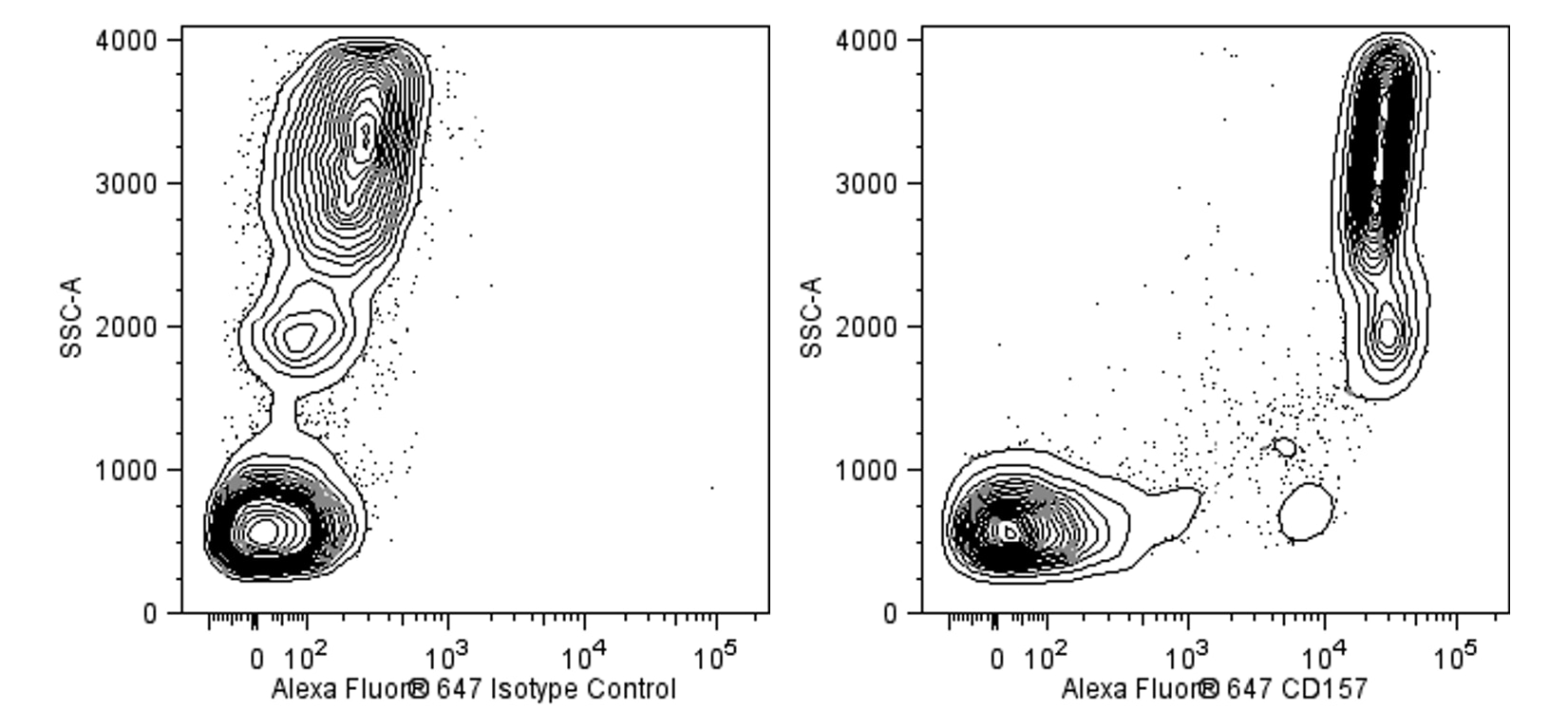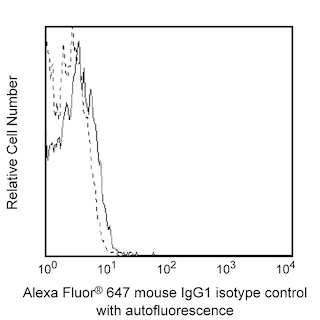-
Your selected country is
Middle East / Africa
- Change country/language
Old Browser
This page has been recently translated and is available in French now.
Looks like you're visiting us from {countryName}.
Would you like to stay on the current country site or be switched to your country?




Multiparameter flow cytometric analysis of CD157 expression on human peripheral blood leucocytes. Whole blood was stained with either Alexa Fluor® 647 Mouse IgG1, κ Isotype Control (Cat. No. 557714; Left Panel) or Alexa Fluor® 647 Mouse Anti-Human CD157 antibody (Cat. No. 564870; Right Panel). Erythrocytes were lysed with BD FACS Lysing Solution (Cat. No. 349202). Two-parameter flow cytometric contour plots showing the correlated expression of CD157 (or Ig Isotype control staining) versus side light-scatter (SSC-A) signals were derived from gated events with the forward and side light-scatter characteristics of intact leucocyte populations. Flow cytometric analysis was performed using a BD LSRFortessa™ Cell Analyzer System.


BD Pharmingen™ Alexa Fluor® 647 Mouse anti-Human CD157

Regulatory Status Legend
Any use of products other than the permitted use without the express written authorization of Becton, Dickinson and Company is strictly prohibited.
Preparation And Storage
Product Notices
- This reagent has been pre-diluted for use at the recommended Volume per Test. We typically use 1 × 10^6 cells in a 100-µl experimental sample (a test).
- An isotype control should be used at the same concentration as the antibody of interest.
- Caution: Sodium azide yields highly toxic hydrazoic acid under acidic conditions. Dilute azide compounds in running water before discarding to avoid accumulation of potentially explosive deposits in plumbing.
- Source of all serum proteins is from USDA inspected abattoirs located in the United States.
- Alexa Fluor® 647 fluorochrome emission is collected at the same instrument settings as for allophycocyanin (APC).
- The Alexa Fluor®, Pacific Blue™, and Cascade Blue® dye antibody conjugates in this product are sold under license from Molecular Probes, Inc. for research use only, excluding use in combination with microarrays, or as analyte specific reagents. The Alexa Fluor® dyes (except for Alexa Fluor® 430), Pacific Blue™ dye, and Cascade Blue® dye are covered by pending and issued patents.
- Alexa Fluor® is a registered trademark of Molecular Probes, Inc., Eugene, OR.
- For fluorochrome spectra and suitable instrument settings, please refer to our Multicolor Flow Cytometry web page at www.bdbiosciences.com/colors.
- Please refer to www.bdbiosciences.com/us/s/resources for technical protocols.
Companion Products





The SY/11B5 monoclonal antibody specifically binds to CD157 which is also known as BST-1 (Bone marrow stromal antigen 1), BP-3/IF-7, Mo5, ADP-ribosyl cyclase 2, and cADPr hydrolase 2. CD157 is a 40-46 kDa glycophosphatidylinositol-linked cell membrane glycoprotein. It is an ectoenzyme that has both cyclic ADP-ribose hydrolase and ADP-ribosyl cyclase activities. CD157 is expressed as a homodimer by a variety of cell types including bone marrow stromal cells, granulocytes, monocytes, macrophages, dendritic cells, endothelial cells, and B and T cell progenitors. In addition to its ectoenzyme activities, CD157 reportedly functions as a receptor involved in neutrophil and monocyte adhesion, transendothelial migration and diapedesis and in tumor cell migration.
Development References (5)
-
Horenstein AL, Sizzano F, Lusso R, et al. CD38 and CD157 ectoenzymes mark cell subsets in the human corneal limbus. Mol Med. 2009; 15(3-4):76-84. (Clone-specific: Fluorescence microscopy, Immunofluorescence, Immunoprecipitation, Western blot). View Reference
-
Malavasi F, Deaglio S, Funaro A, et al. Evolution and function of the ADP ribosyl cyclase/CD38 gene family in physiology and pathology. Physiol Rev. 2008; 88(3):841-886. (Biology). View Reference
-
Ortolan E, Arisio R, Morone S, et al. Functional role and prognostic significance of CD157 in ovarian carcinoma. J Natl Cancer Inst. 2010; 102(15):1160-1177. (Clone-specific: Blocking, Functional assay, Inhibition, Western blot). View Reference
-
Ortolan E, Vacca P, Capobianco A, et al. CD157, the Janus of CD38 but with a unique personality. Cell Biochem Funct. 2002; 20(4):309-322. (Biology). View Reference
-
Quarona V, Zaccarello G, Chillemi A, et al. CD38 and CD157: a long journey from activation markers to multifunctional molecules. Cytometry B Clin Cytom. 2013; 84(4):207-217. (Biology). View Reference
Please refer to Support Documents for Quality Certificates
Global - Refer to manufacturer's instructions for use and related User Manuals and Technical data sheets before using this products as described
Comparisons, where applicable, are made against older BD Technology, manual methods or are general performance claims. Comparisons are not made against non-BD technologies, unless otherwise noted.
For Research Use Only. Not for use in diagnostic or therapeutic procedures.
Report a Site Issue
This form is intended to help us improve our website experience. For other support, please visit our Contact Us page.